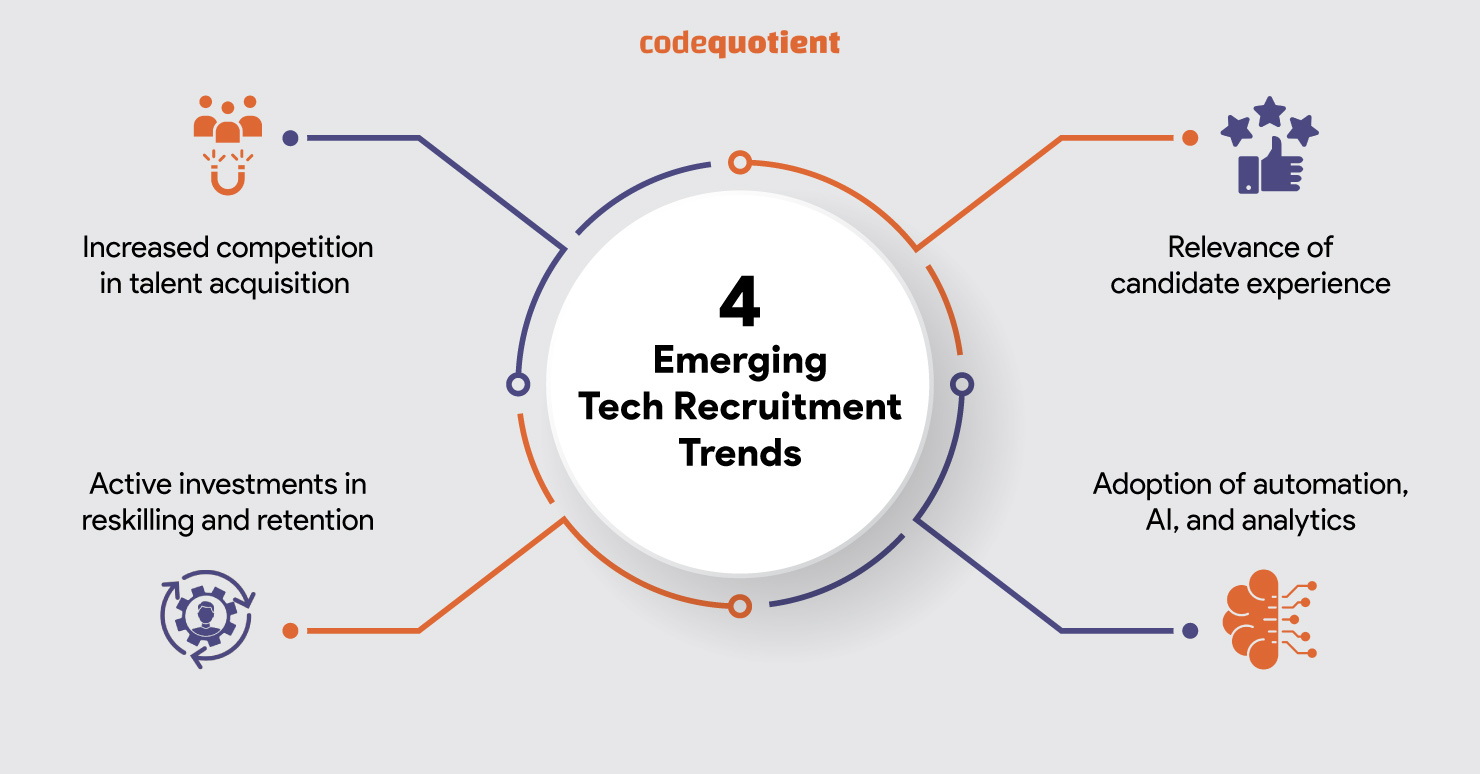It’s been more than a year since the Covid-19 pandemic barged into economies and disrupted everything. The tech industry was no exception. However, the way the tech world embraced this change is commendable.
The sentiment in the industry is now clear. The work-model changes across industries will sustain, and the remote and hybrid work model is the future. But what lies ahead? What will dictate the future of tech recruitment? First, let’s look at some emerging trends that will sustain in the coming years.
Four Emerging Tech Recruitment Trends to Follow
As tech recruitment is going through a metamorphosis, tech professionals are relooking at what they want from their jobs. And recruiters are welcoming innovation. We are looking at four trends at the forefront of the tech recruitment process.
#1. Increased competition in talent acquisition
The global IT industry was aggressively becoming an indispensable industrial and commercial behemoth. Predictions say the software product industry alone will hit $100 billion by 2025.
That said, there was always a demand for qualified tech professionals before 2020. But after the covid-19 pandemic, when businesses were forced to go online, the need for tech pros skyrocketed.
Also taking off with tech demand was the number of new and qualified developers. A study predicted that the global developer population would expand by 500,000 in 2020, to 24.5 million. However, the pandemic limited growth to 2.4% instead of the expected 4%.
Therefore, the equation is clear — a ballooning tech industry and skyrocketing demand for tech pros mean recruiters compete to hire the best from the pool, more than ever!
A boom in work-from-home means tech hiring managers now have access to this broader talent pool, and geography is no longer a boundary.
Moreover, as the demand for tech solutions rises, companies are not shying away from offering hefty raises and joining bonuses. Hence, the competition for tech talent acquisition is likely to sustain in the coming years.
Recommended: Five Tech Recruitment Challenges and How to Overcome Them
#2. Relevance of candidate experience
According to Forbes, top employers who provide excellent candidate experience garner a 99% job acceptance rate. While the organisations offering mediocre candidate experience do not even touch 90%.
LinkedIn reports 83% of candidates are likely to deny an offer if their experience with an organisation was terrible.
Therefore, getting the right fit candidate is no more limited to offering lucrative salaries and perks.
You have to project yourself as the right employer. Candidates prefer working with organisations that take their well-being and work experience seriously.
#3. Adoption of automation, AI, and analytics
Traditionally, companies heavily relied on human resources for the tech recruitment process. But after the pandemic, companies around the globe are investing in progressive three ‘A” approaches– analytics, automation and artificial intelligence.
“The crisis has forced every company into a massive experiment in how to be more nimble, flexible, and fast.”
- Kate Smaje, senior partner, McKinsey & Company
Data analytics in the tech recruitment process empowers recruiters to do an easy SWOT analysis of candidates.
It also significantly reduces the cost of talent acquisition, streamlines the hiring process, and minimises hiring tech HR professionals.
Also, companies are now incorporating machine learning, automation and AI into tech recruitment processes. With the use of AI and automation solutions, companies are now analysing health issues, financial standings and the variables like legal disputes.
In addition, advanced algorithms that use machine learning are helping HR professionals make quick and accurate decisions.
#4. Active investments in reskilling and retention
Since the pandemic emerged, the trend of making the most with the least is only going up. A LinkedIn study states 50% of ‘talent professionals’ are eying to decrease their tech recruitment costs.
The feeling in the industry is to be more efficient with hiring needs, which ultimately reduces the net recruitment budget. To achieve the same goal, companies are relying on the reskilling workforce. When tech professionals continuously look for newer opportunities, the approach aligns with the supply side’s needs.
Recommended: The True Cost Of Hiring a Developer in India
“The future of talent acquisition lies in reskilling rather than finding someone better in the market. If you need to hire today, you need to reskill yesterday.”
– Rajesh Ahuja, Senior Lead- Talent Acquisition, Infosys
As per a Stack Overflow report, after compensation, the second aspect developers are looking for is working on newer technologies. Therefore, active investment in reskilling also increases retention rates in the organisation.
What is CodeQuotient?
The demand for quality tech talents is going up north. CodeQuotient gives you access to a high-quality tech talent pool.
CodeQuotient picks talented developers from colleges and trains them through a mentorship program. Then, they arm them with every skill needed to thrive in the competitive technology world.
Click here to know more about how we can help you! Have queries? Do write to us at info@codequotient.com.





